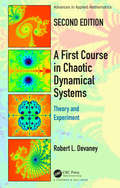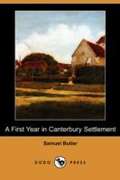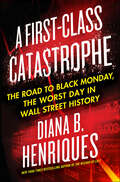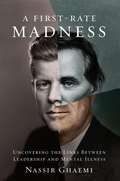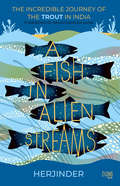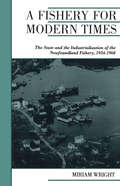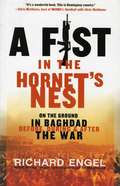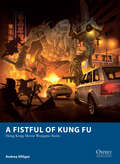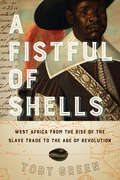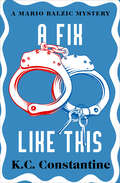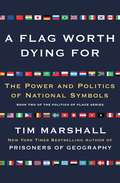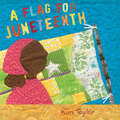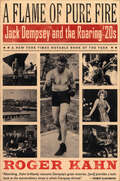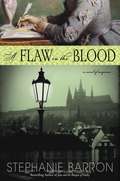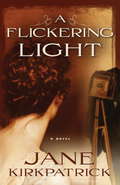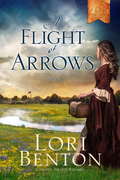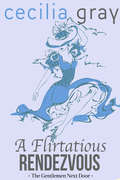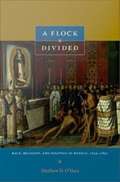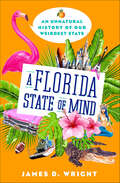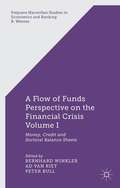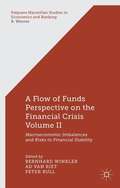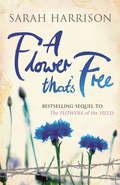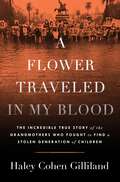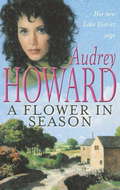- Table View
- List View
A First Course In Chaotic Dynamical Systems: Theory And Experiment
by Robert L. DevaneyA First Course in Chaotic Dynamical Systems: Theory and Experiment, Second Edition The long-anticipated revision of this well-liked textbook offers many new additions. In the twenty-five years since the original version of this book was published, much has happened in dynamical systems. Mandelbrot and Julia sets were barely ten years old when the first edition appeared, and most of the research involving these objects then centered around iterations of quadratic functions. This research has expanded to include all sorts of different types of functions, including higher-degree polynomials, rational maps, exponential and trigonometric functions, and many others. Several new sections in this edition are devoted to these topics. The area of dynamical systems covered in A First Course in Chaotic Dynamical Systems: Theory and Experiment, Second Edition is quite accessible to students and also offers a wide variety of interesting open questions for students at the undergraduate level to pursue. The only prerequisite for students is a one-year calculus course (no differential equations required); students will easily be exposed to many interesting areas of current research. This course can also serve as a bridge between the low-level, often non-rigorous calculus courses, and the more demanding higher-level mathematics courses. Features More extensive coverage of fractals, including objects like the Sierpinski carpet and othersthat appear as Julia sets in the later sections on complex dynamics, as well as an actualchaos "game." More detailed coverage of complex dynamical systems like the quadratic familyand the exponential maps. New sections on other complex dynamical systems like rational maps. A number of new and expanded computer experiments for students to perform. About the Author Robert L. Devaney is currently professor of mathematics at Boston University. He received his PhD from the University of California at Berkeley under the direction of Stephen Smale. He taught at Northwestern University and Tufts University before coming to Boston University in 1980. His main area of research is dynamical systems, primarily complex analytic dynamics, but also including more general ideas about chaotic dynamical systems. Lately, he has become intrigued with the incredibly rich topological aspects of dynamics, including such things as indecomposable continua, Sierpinski curves, and Cantor bouquets.
A First Year in Canterbury Settlement
by Samuel ButlerA First Year in Canterbury Settlement, the earliest book by Butler, is a beautifully narrated tale of a colonial settler. <P> <P> Through journal of the author as a young emigrant, we get a first-hand account of his sea voyage to New Zealand. The vibrant descriptions of flora and fauna of the new land show his keen interest in everything, from exploration of the terrain to sheep-farming. Informative!
A First-Class Catastrophe: The Road to Black Monday, the Worst Day in Wall Street History
by Diana B. HenriquesThe definitive account of the crash of 1987, a cautionary tale of how the U.S. financial system nearly collapsed--from the bestselling author of The Wizard of LiesMonday, October 19, 1987, was by far the worst day in Wall Street history. The market fell 22.6 percent – almost twice as bad as the worst day of 1929 – equal to a one-day loss of nearly 5,000 points today.Black Monday was more than seven years in the making and threatened nearly every U.S. financial institution. Drawing on superlative archival research and dozens of original interviews Diana B. Henriques weaves a tale of missed opportunities, market delusions, and destructive actions that stretched from the “silver crisis” of 1980 to turf battles in Washington, a poisonous rivalry between the New York Stock Exchange and the Chicago Mercantile Exchange, and the almost-fatal success of two California professors whose idea for reducing market risk spun terribly out of control. As the story hurtles forward, the players struggle to forestall a looming market meltdown and unexpected heroes step in to avert total disaster.For thirty years, investors, regulators, and bankers have failed to heed the lessons of 1987, even as the same patterns have resurfaced, most spectacularly in the financial crisis of 2008. A First-Class Catastrophe offers a new way of looking not only at the past, but at our financial future as well.
A First-Rate Madness: Uncovering the Links Between Leadership and Mental Illness (Playaway Adult Nonfiction Ser.)
by Nassir GhaemiAn investigation into the surprisingly deep correlation between mental illness and successful leadership, as seen through some of history's greatest politicians, generals, and businesspeople. In A First-Rate Madness, Nassir Ghaemi, who runs the Mood Disorders Program at Tufts University Medical Center, draws from the careers and personal plights of such notable leaders as Lincoln, Churchill, Gandhi, Martin Luther King, Jr. , JFK, and others from the past two centuries to build an argument at once controversial and compelling: the very qualities that mark those with mood disorders- realism, empathy, resilience, and creativity-also make for the best leaders in times of crisis. By combining astute analysis of the historical evidence with the latest psychiatric research, Ghaemi demonstrates how these qualities have produced brilliant leadership under the toughest circumstances. Take realism, for instance: study after study has shown that those suffering depression are better than "normal" people at assessing current threats and predicting future outcomes. Looking at Lincoln and Churchill among others, Ghaemi shows how depressive realism helped these men tackle challenges both personal and national. Or consider creativity, a quality psychiatrists have studied extensively in relation to bipolar disorder. A First-Rate Madness shows how mania inspired General Sherman and Ted Turner to design and execute their most creative-and successful-strategies. Ghaemi's thesis is both robust and expansive; he even explains why eminently sane men like Neville Chamberlain and George W. Bush made such poor leaders. Though sane people are better shepherds in good times, sanity can be a severe liability in moments of crisis. A lifetime without the cyclical torment of mood disorders, Ghaemi explains, can leave one ill equipped to endure dire straits. He also clarifies which kinds of insanity-like psychosis-make for despotism and ineptitude, sometimes on a grand scale. Ghaemi's bold, authoritative analysis offers powerful new tools for determining who should lead us. But perhaps most profoundly, he encourages us to rethink our view of mental illness as a purely negative phenomenon. As A First-Rate Madness makes clear, the most common types of insanity can confer vital benefits on individuals and society at large-however high the price for those who endure these illnesses. .
A Fish in Alien Streams: The Incredible Journey of the Trout in India
by Herjinder Singh SahniTHE NEVER-BEFORE-TOLD STORY OF HOW THE TROUT CAME TO CALL INDIAN RIVERS ITS HOME. When the East India Company's business venture with India turned into a full-fledged occupation of the country, the British in India, apart from establishing their governance, were concerned with one more thing - how to make their surroundings here more akin to their homeland. Even as they dotted the Indian terrain with their manicured gardens, clock towers and pristine colonial structures, many among them (particularly a clutch of British anglers) increasingly felt the absence of one essential fish in Indian rivers - the trout. A Fish in Alien Streams presents the astounding story of a motley group of mavericks, adventurers and eccentric naturalists who, driven by their peculiar fixation, were obsessed with introducing the trout to India's rivers.This delightful account of an unknown slice of India's colonial past combines incredible research involving antique books, rare documents and letters of wistful longing for the trout with the minutiae of fishing and skilful planning. Spanning the Kashmir valley, Kullu, Uttarkashi, the Nilgiris, Travancore and Ceylon (now Sri Lanka), this unique and incredible tale is about magnificent passions, countless failures and ultimate triumph.
A Fishery for Modern Times
by Miriam WrightIn the early 1990s, the northern cod populations off the coast of Newfoundland had become so depleted that the federal government placed a moratorium on commercial fishing. The impact was devastating, both for Newfoundland's economy and for local fishing communities. Today, although this natural resource - exploited commercially for over 500 years - appears to be returning in diminished numbers, many fisheries scientists and fishers question whether the cod will ever return to its former abundance.In A Fishery for Modern Times, Miriam Wright argues that the recent troubles in the fishery can be more fully understood by examining the rise of the industrial fishery in the mid-twentieth century. The introduction of new harvesting technologies and the emergence of 'quick freezing', in the late 1930s, eventually supplanted household production by Newfoundland's fishing families. While the new technologies increased the amount of fish caught in the northwest Atlantic, Wright argues that the state played a critical role in fostering and financing the industrial frozen fish sector. Many bureaucrats and politicians, including Newfoundland's premier, Joseph Smallwood, believed that making the Newfoundland fishery 'modern', with centralization, technology, and expertise, would transform rural society, solving deep-seated economic and social problems.A Fishery for Modern Times examines the ways in which the state, ideologies of development, and political, economic, and social factors, along with political actors and fishing company owners, contributed to the expansion of the industrial fishery from the 1930s through the 1960s. While the promised prosperity never fully materialized, the continuing reliance on approaches favouring high-tech, big capital solutions put increasing pressure on cod populations in the years that followed. As Wright concludes, 'We can no longer afford to view the fisheries resources as "property" of the state and industry, to do with it as they choose. That path had led only to devastation of the resource, economic instability, and great social upheaval.'
A Fist in the Hornet's Nest: On the Ground in Baghdad Before, During & After the War
by Richard EngelWhen war broke out in Iraq, every major U.S. network pulled its correspondents from the scene. Despite the risk, Richard Engel stayed. As our tanks entered Baghdad in April 2003, he was there, bringing the Iraqi war into American homes as a stringer for ABC news. Determined to deliver the whole Middle East story, Engel moved to Cairo in 1996 after graduating from Stanford to learn 'street' Arabic. Then to dig even deeper into the complicated powder-keg of the Israeli-Palestinian conflict, he settled in Jerusalem.Now as Iraq enters its post-war phase and the Gulf region continues to dominate our nation's consciousness, more and more Americans will come to know and trust Richard Engel--especially in his current role as a correspondent for NBC Nightly News with Tom Brokaw. Both analytical and anecdotal, this book leads us through the war in Iraq, dissecting a myriad of Middle East issues, all from the vantage point of someone who is 'on the ground and in the streets' to get the real story.
A Fistful of Kung Fu - Hong Kong Movie Wargame Rules
by Fabien Lascombe Andrea SfiligoiRecreate scenes from Hong Kong action cinema like Enter the Dragon, Kill Bill, Big Trouble in Little China, Crouching Tiger - Hidden Dragon, and Hard Boiled. A Fistful of Kung Fu is set in a modern world walking a precarious line between the technological advances of next-generation technology and the tradition and mysticism of ancient cultures. Kung Fu schools face off in no-holds barred martial arts tournaments. Evil corporations hire hitmen and infiltrators to steal each other's secrets. Overworked SWAT teams respond to street-level gunfights between feuding Triad and Yakuza clans. Ancient artefacts are sought by hopping vampires and cyborgs alike, each seeking to harness the power of the Four Dragon Kings and control the world. Bullets, punches, kicks and throwing stars fly in slow motion as martial arts heroes and gun-wielding cops defeat enemy after enemy in the pursuit of evil masterminds.Possible factions range from Chinese Triads and the Japanese Yakuza to Ninja clans, martial arts schools, the men and women of the Hong Kong Police Department, demons, secret societies and almost anything else you can imagine! All struggle for supremacy - destroying the city in the process.A Fistful of Kung Fu uses a colored dice system to keep track of wounds and fatigue of the main characters. Mooks and supporting cast are swatted like flies, but can still be dangerous when given the advantage of numbers or automatic weaponry. Based on the popular Ganesha Games rules system, A Fistful of Kung Fu introduces martial arts combat with manoeuvres that have different outcomes depending on the degree of success, and which allow for counter-attacks when they fail, giving a flowing, appropriate combat system. The game also includes rules for challenges and "gun-fu" stunts. Each gang in the game comprises 1-3 principal characters and 5-15 mooks that move as small groups of up to 5 models each.
A Fistful of Shells: West Africa from the Rise of the Slave Trade to the Age of Revolution
by Toby GreenBy the time the “Scramble for Africa” among European colonial powers began in the late nineteenth century, Africa had already been globally connected for centuries. Its gold had fueled the economies of Europe and the Islamic world for nearly a millennium, and the sophisticated kingdoms spanning its west coast had traded with Europeans since the fifteenth century. Until at least 1650, this was a trade of equals, using a variety of currencies—most importantly, cowrie shells imported from the Maldives and nzimbu shells imported from Brazil. But, as the slave trade grew, African kingdoms began to lose prominence in the growing global economy. We have been living with the effects of this shift ever since. With A Fistful of Shells, Toby Green transforms our view of West and West-Central Africa by reconstructing the world of these kingdoms, which revolved around trade, diplomacy, complex religious beliefs, and the production of art. Green shows how the slave trade led to economic disparities that caused African kingdoms to lose relative political and economic power. The concentration of money in the hands of Atlantic elites in and outside these kingdoms brought about a revolutionary nineteenth century in Africa, parallel to the upheavals then taking place in Europe and America. Yet political fragmentation following the fall of African aristocracies produced radically different results as European colonization took hold. Drawing not just on written histories, but on archival research in nine countries, art, oral history, archaeology, and letters, Green lays bare the transformations that have shaped world politics and the global economy since the fifteenth century and paints a new and masterful portrait of West Africa, past and present.
A Fix Like This (The Mario Balzic Mysteries)
by K.C. ConstantineFrom an Edgar Award–nominated author, a small-town chief of police is pushed to his limits while going up against a local crime syndicate. The near-fatal stabbing of Armand &“Fat Manny&” Manditti, a numbers runner working for the local mob boss, has chief of police Mario Balzic in a bind. Neither Fat Manny nor his brother Tullio are talking, probably because they are putting together a revenge plan that will soon turn the small rust-belt town of Rocksburg into a morgue. Unless Balzic can come up with the perp before they do. It&’s the kind of fix that can get even the most conscientious cop in trouble. . . . &“Constantine is a marvelous writer. May Mario Balzic thrive.&” —The New York Times &“K.C. Constantine is one of the most talked about mystery writers on the American scene. Constantine has a smooth style, and his plots are loaded with unexpected twists and turns.&” ―Boston Globe &“Constantine writes a terrific mystery.&” ―Providence Journal
A Flag Worth Dying For: The Power and Politics of National Symbols (Politics of Place #2)
by Tim MarshallCombining keen analysis of current events with world history, Tim Marshall, author of the New York Times bestseller Prisoners of Geography, provides &“an entertaining whistle-stop tour of world flags&” (Library Journal)—how their power is used to unite and divide populations and intimidate enemies.For thousands of years flags have represented our hopes and dreams. We wave them. Burn them. March under their colors. And still, in the twenty-first century, we die for them. Flags fly at the UN, on Arab streets, from front porches in Texas. They represent the politics of high power as well as the politics of the mob. From the renewed sense of nationalism in China, to troubled identities in Europe and the USA, to the terrifying rise of Islamic State, the world is a confusing place right now and it&’s important to understand the symbols, old and new, that people are rallying around. In nine chapters (covering the USA, UK, Europe, Middle East, Asia, Africa, Latin America, international flags, and flags of terror), Tim Marshall&’s A Flag Worth Dying For is a &“brisk, entertaining read…that successfully answers a puzzling question: how can a simple piece of cloth come to mean so much? Marshall presents an informative survey of these highly visible symbols of national or international pride&” (Publishers Weekly), representing nation states and non-state actors (including ISIS, Hezbollah, and Hamas), and explains how they figure in diplomatic relations and events today. Drawing on more than twenty-five years of global reporting experience to reveal the true meaning behind the symbols that unite us—and divide us—Marshall &“writes with the cool drollery that characterized the work of Christopher Hitchens or Simon Winchester&” (USA TODAY). The &“illuminating&” (The New York Times) A Flag Worth Dying For is a winning combination of current affairs, politics, and world history and &“a treasure vault for vexillologists, full of meaning beyond the hue and thread of the world&’s banners&” (Kirkus Reviews).
A Flag for Juneteenth
by Kim TaylorExpert quilter Kim Taylor shares a unique and powerful story of the celebration of the first Juneteenth, from the perspective of a young girl. <P><P> On June 19, 1865, in Galveston, General Gordon Granger of the Union Army delivered the message that African Americans in Texas were free. Since then, Juneteenth, as the day has come to be known, has steadily gained recognition throughout the United States. ln 2020,a powerful wave of protests and demonstrations calling for racial justice and equality brought new awareness to the significance of the holiday. <P><P> A Flag for Juneteenth depicts a close-knit community of enslaved African Americans on a plantation in Texas, the day before the announcement is to be made that all enslaved people are free. Young Huldah, who is preparing to celebrate her tenth birthday, can’t possibly anticipate how much her life will change that Juneteenth morning. The story follows Huldah and her community as they process the news of their freedom and celebrate together by creating a community freedom flag. <P><P> Debut author and artist Kim Taylor sets this story apart by applying her skills as an expert quilter. Each of the illustrations has been lovingly hand sewn and quilted, giving the book a homespun, tactile quality that is altogether unique. <P><P><i>Advisory: Bookshare has learned that this book offers only partial accessibility. We have kept it in the collection because it is useful for some of our members. Benetech is actively working on projects to improve accessibility issues such as these.</i>
A Flame of Pure Fire: Jack Dempsey and the Roaring '20s
by Roger KahnJack Dempsey was perfectly suited to the time in which he fought, the time when the United States first felt the throb of its own overwhelming power. For eight years and two months after World War I, Dempsey, with his fierce good looks and matchless dedication to the kill, was heavyweight champion of the world. A Flame of Pure Fire is the extraordinary story of a man and a country growing to maturity in a blaze of strength and exuberance that nearly burned them to ash. Hobo, roughneck, fighter, lover, millionaire, movie star, and, finally, a gentleman of rare generosity and sincerity, Dempsey embodied an America grappling with the confusing demands of preeminence. Dempsey lived a life that touched every part of the American experience in the first half of the twentieth century. Roger Kahn, one of our preeminent writers about the human side of sport, has found in Dempsey a subject that matches his own manifold talents. A friend of Dempsey's and an insightful observer of the ways in which sport can measure a society's evolution, Kahn reaches a new and exciting stage in his acclaimed career with this book. In the story of a man John Lardner called "a flame of pure fire, at last a hero," Roger Kahn finds the heart of America.
A Flaw in the Blood
by Stephanie BarronThe acclaimed author of the bestselling Jane Austen mysteries brings rich historical immediacy to an enthralling new suspense novel centered around Queen Victoria's troubled court...and a secret so dangerous, it could topple thrones. Windsor Castle, 1861. Prince Albert, the Queen's Consort, lies dying, and Victoria summons Patrick Fitzgerald, the clever, embittered Irish barrister who helped defend Her Majesty from a would-be assassin twenty years earlier. Within hours, Fitzgerald's beautiful ward is nearly murdered, his chambers are ransacked, and another girl lies dead. Could an unknown force at Windsor want Fitzgerald silenced? And why? The answers are entangled in an electrifying tale of intrigue, seduction, and betrayal, partially narrated by Europe's most powerful monarch. As fascinating as the Queen herself, seamlessly blending history and suspense,A Flaw in the Bloodis an elegant thriller that is utterly convincing--and utterly surprising--to its very end.
A Flickering Light (Portraits of the Heart #1)
by Jane KirkpatrickReturning to her Midwest roots, award-winning author Jane Kirkpatrick draws a page from her grandmother's photo album to capture the interplay between shadow and light, temptation and faith that marks a woman's pursuit of her dreams.She took exquisite photographs, but her heart was the true image exposed. Fifteen-year-old Jessie Ann Gaebele loves nothing more than capturing a gorgeous Minnesota landscape when the sunlight casts its most mesmerizing shadows. So when F.J. Bauer hires her in 1907 to assist in his studio and darkroom, her dreams for a career in photography appear to find root in reality. With the infamous hazards of the explosive powder used for lighting and the toxic darkroom chemicals, photography is considered a man' s profession. Yet Jessie shows remarkable talent in both the artistry and business of running a studio. She proves less skillful, however, at managing her growing attraction to the very married Mr. Bauer.This luminous coming-of-age tale deftly exposes the intricate shadows that play across every dream worth pursuing-and the irresistible light that beckons the dreamer on.From the Trade Paperback edition.
A Flight of Arrows: A Novel
by Lori BentonHearts are Divided Loyalties Will Be Tested The Fates of Two Families Hang in the Balance Twenty years past, in 1757, a young Redcoat, Reginald Aubrey stole a newborn boy--the lighter-skinned of Oneida twins-- during the devastating fall of Fort William Henry and raised him as his own. No one connected to Reginald escaped unscathed from this crime. Not his adopted daughter Anna. Not Stone Thrower, the Native American father determined to get his son back. Not Two Hawks, William's twin brother separated since birth, living in the shadow of his absence and hoping to build a future with Anna. Nor Lydia, who longs for Reginald to be free from his self-imposed emotional prison and embrace God's forgiveness-- and her love. Now William, whose identity has been shattered after discovering the truth of his birth, hides in the ranks of an increasingly aggressive British army. The Redcoats prepare to attack frontier New York and the Continentals, aided by Oneida warriors including Two Hawks, rally to defend it. As the Revolutionary War penetrates the Mohawk Valley, two families separated by culture, united by love and faith, must find a way to reclaim the son marching toward them in the ranks of their enemies. Book 2 in the Pathfinder SeriesFrom the Trade Paperback edition.
A Flirtatious Rendezvous: The Gentlemen Next Door (The\gentlemen Next Door Ser. #4)
by Cecilia GrayIn the spirit of Georgette Heyer, this delightful Regency romp offers a humorous and heartwarming tale... The whole series was freaking adorable and fun. --Shari, the Delighted ReaderMiss Hanna Morton is:1. An affectionately dutiful daughter2. A hopeless romantic 3. Desperately in love with one Mr. Hayden Banks despite good sense advising her to the contrary.Mr. Hayden Banks is:1. A reluctantly dutiful son 2. An ingenious mathematician 3. Incredibly wary of one Miss Hanna Morton when his matchmaking mother sets them under the same roof.Hanna is hoping for Hayden's heart, but what will become of their flirtatious rendezvous? * * *ABOUT THE GENTLEMEN NEXT DOOR SERIESThe complete series of novellas is available now! Don't miss The Gentlemen Next Door, because sometimes a lady in need of love need look no further than next door. Each of these shorter, sweet stories can be enjoyed as a standalone, but if you love one, then you'll probably love the entire series.Book 1: A Delightful ArrangementBook 2: An Illicit EngagementBook 3: A Dangerous ExpectationBook 4: A Flirtatious RendezvousCharacters you meet in The Gentlemen Next Door also appear in the Kiss A Belle series, which features longer novels. While each story can be enjoyed as a standalone, you may want to read them all. Books 1-3 occur concurrently and can be read in any order; Books 4 and 5 follow respectively.Book 1: Kiss Me AfterBook 2: Kiss Me DarklyBook 3: Kiss Me SweetlyBook 4: Kiss Me SoftlyBook 5: Kiss Me Again* * *MORE PRAISE FOR THE GENTLEMEN NEXT DOORI can't wait to read the next one. That is how addicting this series is. --Lady Armstrong, NetgalleyThese books are like a Snickers bar... a satisfying snack for the romantic's proverbial sweet tooth. --J. Yaggi, NetgalleyThis is a charming, sweet tale with vibrant, believable characters and witty, humorous dialogue. Ms. Gray has outdone herself with this poignant, character-driven novella. --Joyously Retired Teacher, Amazon.comCaptures your attention from the first page. --The Lady Reads @ AmazonA wonderful book and a great read. --Bunny's ReviewThis is a delightful story, well-written, historically accurate and intriguing. --B.S. Andrews @ Amazon
A Floating Chinaman: Fantasy and Failure across the Pacific
by Hua HsuWho gets to speak for China? During the interwar years, when American condescension toward China yielded to fascination with all things Chinese, a circle of writers sparked an unprecedented conversation over U.S.-Chinese relations. Hua Hsu tells how they became ensnared in bitter rivalries over who could claim the title of leading China expert.
A Flock Divided: Race, Religion, and Politics in Mexico, 1749-1857
by Matthew D. O'HaraCatholicism, as it developed in colonial Mexico, helped to create a broad and remarkably inclusive community of Christian subjects, while it also divided that community into countless smaller flocks. Taking this contradiction as a starting point, Matthew D. O'Hara describes how religious thought and practice shaped Mexico's popular politics. As he shows, religion facilitated the emergence of new social categories and modes of belonging in which individuals--initially subjects of the Spanish crown, but later citizens and other residents of republican Mexico--found both significant opportunities for improving their place in society and major constraints on their ways of thinking and behaving. O'Hara focuses on interactions between church authorities and parishioners from the late-colonial era into the early-national period, first in Mexico City and later in the surrounding countryside. Paying particular attention to disputes regarding caste status, the category of "Indian," and the ownership of property, he demonstrates that religious collectivities from neighborhood parishes to informal devotions served as complex but effective means of political organization for plebeians and peasants. At the same time, longstanding religious practices and ideas made colonial social identities linger into the decades following independence, well after republican leaders formally abolished the caste system that classified individuals according to racial and ethnic criteria. These institutional and cultural legacies would be profound, since they raised fundamental questions about political inclusion and exclusion precisely when Mexico was trying to envision and realize new forms of political community. The modes of belonging and organizing created by colonialism provided openings for popular mobilization, but they were always stalked by their origins as tools of hierarchy and marginalization.
A Florida State of Mind: An Unnatural History of Our Weirdest State
by James D. WrightA witty history of the state that's always in the news, for everything from alligator attacks to zany crimes.There's an old clip of Bugs Bunny sawing the entire state of Florida off the continent—and every single time a news story springs up about some shenanigans in Florida, someone on the internet posts it in response. Why are we so ready to wave goodbye to the Sunshine State? In A Florida State of Mind: An Unnatural History of Our Weirdest State, James D. Wright makes the case that there are plenty of reasons to be scandalized by the land and its sometimes-kooky, sometimes-terrifying denizens, but there's also plenty of room for hilarity.Florida didn't just become weird; it's built that way. Uncharted swampland doesn't easily give way to sprawling suburbia. It took violent colonization, land scams to trick non-Floridians into buying undeveloped property, and the development of railroads to benefit one man's hotel empire.Even the most natural parts of Florida are unnatural. Florida citrus? Not from here, but from China. Gators? Oh, they're from Florida all right, but that doesn't make having 1 per every 20 humans normal. Animals...in the form of roadkill? Only Florida allows you to keep anything you kill on the road (and anything you find). Yet everyone loves Florida: tourists come in droves, and people relocate to Florida constantly (only 36% of residents were born there). Crammed with unforgettable stories and facts, Florida will show readers exactly why.
A Flow-of-funds Perspective On The Financial Crisis
by Peter Bull Bernhard Winkler Ad Van RietProvides a comprehensive overview of a broad range of uses of the flow of funds within the central bank community as well as in the academic field, prepared by international experts in the field. Based on the crisis experience, it offers an overview of lessons for macrofinancial analysis and financial stability.
A Flow-of-funds Perspective On The Financial Crisis
by Peter Bull Bernhard Winkler Ad Van RietProvides a comprehensive overview of a broad range of uses of the flow of funds within the central bank community as well as in the academic field, prepared by international experts in the field. Based on the crisis experience, it offers an overview of lessons for macrofinancial analysis and financial stability.
A Flower That's Free: The bestselling sequel to The Flowers of the Field
by Sarah HarrisonSequel to the international bestseller, THE FLOWERS OF THE FIELD, this is an epic novel set amid the turbulence of the Second World War.'This is the second in the trilogy and, like the first, I cannot put it down. Sarah Harrison is such a good writer' Amazon reviewer, 5 starsKate Kingsley remembers little of her early childhood, other than the devastation of being torn away from everything she knew in France and sent to live as the adopted daughter of Jack and Thea in Kenya.Now 20, she leaves for a new life in London. But this is 1936 - a time of decadence, but also turmoil.Kate finds an unexpected ally in her Aunt Dulcie, whose own life is anything but straightforward. When Kate falls in love she believes she has found a soul mate. But this is just the start of a journey during which Kate confronts personal danger, faces conflicting loyalties, and must make a heart-breaking choice.'Harrison is a writer with a gift for mixing candour [and] compassion' You magazine
A Flower Traveled in My Blood: The Incredible True Story of the Grandmothers Who Fought to Find a Stolen Generation of Children
by Haley Cohen Gilliland&“[An] astonishing story…Powerful…Harrowing…Absorbing and lucid…You would have to harden your heart to be unmoved by the Abuelas&’ quest.&” —Jennifer Szalai, The New York Times &“Inspiring…A triumphant saga of ordinary people doing extraordinary things in the face of pure malevolence.&” —Hampton Sides • &“Enthralling…Written with the nail-biting verve of a thriller.&” —Publishers Weekly (starred review) • &“Extraordinary...A harrowing and timely reminder of what happens when democracy succumbs to despotism.&” —Adam Higginbotham • &“A heartbreaking and humane story of devotion and moral courage.&” —Robert Kolker • &“Piercing, emotional...Will resonate for generations.&” —Kirkus Reviews (starred review) A remarkable new talent in narrative nonfiction delivers the epic true story of a group of courageous grandmothers who fought to find their grandchildren who were stolen.In the early hours of March 24, 1976, the streets of Buenos Aires rumble with tanks as soldiers seize the presidential palace and topple Argentina&’s leader. The country is now under the control of a military junta, with army chief Jorge Rafael Videla at the helm. With quiet support from the United States and tacit approval from much of Argentina&’s people, who are tired of constant bombings and gunfights, the junta swiftly launches the National Reorganization Process or El Proceso—a bland name masking their ruthless campaign to crush the political left and instill the country with &“Western, Christian&” values. The junta holds power until 1983 and decimates a generation. One of the military&’s most diabolical acts is kidnapping hundreds of pregnant women. After giving birth in captivity, the women are &“disappeared,&” and their babies secretly given to other families—many of them headed by police or military officers. For mothers of pregnant daughters and daughters-in-law, the source of their grief is twofold—the disappearances of their children, and the theft of their grandchildren. A group of fierce grandmothers forms the Abuelas de Plaza de Mayo, dedicated to finding the stolen infants and seeking justice from a nation that betrayed them. At a time when speaking out could mean death, the Abuelas confront military officers and launch protests to reach international diplomats and journalists. They become detectives, adopting disguises to observe suspected grandchildren, and even work alongside a renowned American scientist to pioneer groundbreaking genetic tests. A Flower Traveled in My Blood is the rarest of nonfiction that reads like a novel and puts your heart in your throat. It is the product of years of extensive archival research and meticulous, original reporting. It marks the arrival of a blazing new talent in narrative journalism. In these pages, a regime tries to terrorize a country, but love prevails. The grandmothers&’ stunning stories reveal new truths about memory, identity, and family.
A Flower in Season
by Audrey HowardBriony Marsden has led a hard life, forced to do the work of a grown man while enduring her drunkard father?s taunts and blows. But when he goes too far one day, her fate becomes even worse as she makes her way alone in a heartless world. Not quite alone. She has a friend - Lizzie Jenkins - who will do anything to help Briony re-open Moorend Mill. And Chad Cameron, the richest man in the district, has always admired Briony?s spirit and determination. When her fortunes are at their lowest, he falls in love with the elfin waif and decides to make her his wife. But the only way he can win her is by trickery - by betraying her naive trust in the man who came to her rescue when all seemed lost. Can their marriage survive when she discovers his deception?
